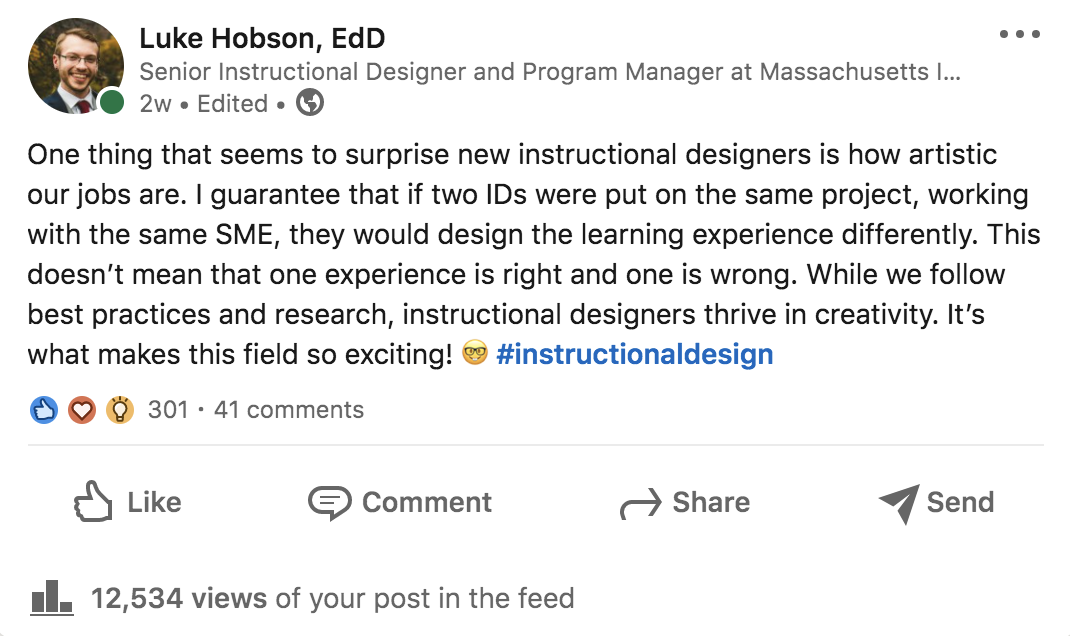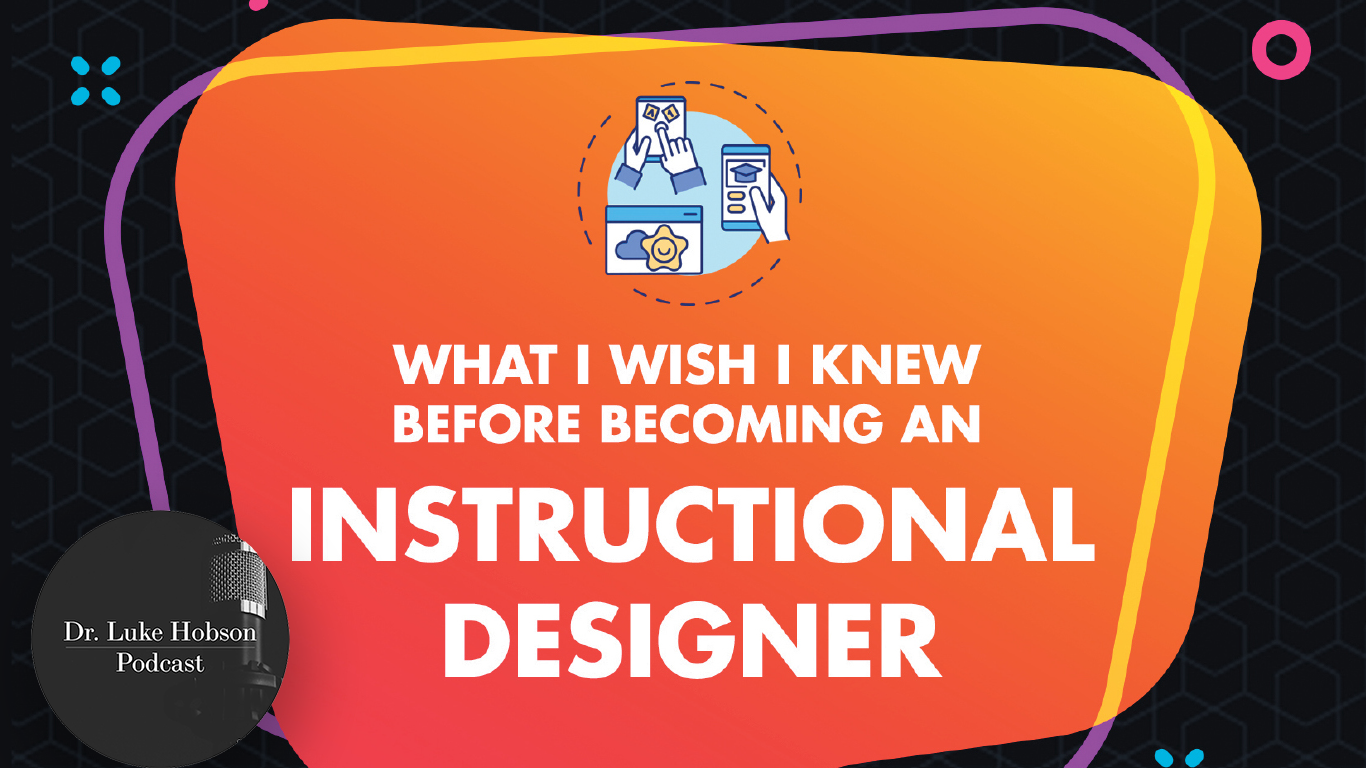Is Instructional Design a Form of Art?
If you were to ask an instructional designer to describe their job, you’ll hear about designing the online learning experience, collaborating with subject matter experts, developing products, and creating learning outcomes, objectives, assessments, and content. One phrase that you won’t hear about is how artistic the instructional design role can be. While I’ve always had this preliminary thought, it wasn’t until working on a recent project where the light bulb went off over my head. Instructional design to me is artistic in nature and here’s how I arrived at that conclusion.
I was tasked with reviewing multiple courses on leadership that were all designed to train the next up-and-coming leaders in tech. The goal was to create a common thread between them to weave together the ultimate tech leadership program. As I began to review each module, I was stunned by how amazingly different the courses were designed. Each one of them had their own unique flare that set them apart from the rest. This does make sense as there were at least four instructional designers involved in designing all of the courses. Each designer brought their own creativity to the table along with ideas from SMEs. While every course followed MIT’s guidelines and best practices for online learning, they were still purposefully distinct to showcase the goals of each course. Before long, I became excited to see what was in store for me pretending to be the learner and it prompted me to write this post on LinkedIn:
When I wrote this, I was envisioning what would happen if I was the designer on each project.
How would I design the learning experience differently?
Would my partnerships with SMEs lead to other ideas?
Would my background enhance an assignment because I’ve had experience in the field?
If you presented to me the same circumstances with the goals, problems, content, and SME, I bet that my learning experience would be different compared to my peers. Not that one way is right and one is wrong, but rather, our experiences as designers are reflected onto our courses. I also have to acknowledge that restraints will play an enormous factor into how a program is designed. If you give me all of the time, budget, resources, and a fantastic SME, the design will absolutely be different compared to a tight deadline, shoestring budget, limited resources, and an unenthusiastic person to work with. For new instructional designers, I know that this is a baffling topic. You hear about best practices, recommended software, learning sciences, and so on. I’m not discounting any of those concepts as they do come into play and influence our decisions.
Let’s do a bit of a mental exercise here.
Imagine for a second that I give you a blank canvas, some paint, and a few brushes. I provide instructions to paint for me a beautiful New England fall scene. What comes to mind when I say this? Maybe an image of apple picking, pumpkins, red, orange, and yellow leaves, the mountains, corn mazes, or something else. Whatever you decide to create, that is your perspective. You have a mental range of what you are thinking about and anything that falls (no pun intended) into this category, can be deemed as a fall scene.
Take this concept, and think about it like an instructional designer. Your blank canvas is the course. Your paint set is the learning outcomes. Your brushes are the learning objectives. What you decide to “paint” will become the product. Your SMEs and colleagues in this metaphor serve as the art critics and art teachers. Their feedback becomes incorporated to create a final masterpiece.
So, what does this look like in a real-world setting? Let’s say that the SME and yourself decide that it would be a good idea to include a discussion element in the course to help make the learners network together. How do you envision this discussion taking place? Based on your resources, the target audience, and your limitations, this could look drastically different.
You could create a:
Virtual space for learners to connect in GatherTown
Mobile friendly platform like Slack for your learners to connect in their own private channels
Professional networking environment like a LinkedIn Group
Sophisticated discussion platform with upvoting, sharing, and liking such as YellowDig
Designated breakout room with Zoom or another video-based platform
Standard discussion board within the LMS
The “correct” answer depends on a number of circumstances, but this could be one step in the right direction. I didn’t even get into the kind of activity you could create around the concept of networking. I only mentioned a variety of platforms for a designer to think about when it comes to the purpose and functionality of networking within the program.
Your creativity levels will need to multiply when thinking about assessments for a course and I’d argue that this is where the artistic form truly happens. What kind of assessment will be relevant, engaging, and appropriate for the target audience and the goals of the course?
Peer-Reviewed
Scenario-Based
Problem-Based
Project-Based
Gamification
Simulations
Presentations
Team-Based
Case Studies
The list goes on and on, and that’s what makes the instructional design role challenging and fun. You mix and match these ideas to create the learning experience. Let’s say that my goal of the networking activity is to have learners become more comfortable with networking online and they will practice this skill to be used in their own organizations and professions. From experience, I know that networking in the workplace is complexed, especially within massive organizations.
To help learners practice this networking skill and to become more comfortable with talking to one another in the course, I could create a scenario-based problem. In the scenario, I’d ask learners to imagine themselves in the shoes of a character who is trying to lead a change at their organization. In order for this change to manifest, they need the buy-in from influential co-workers. In the scenario, the character identifies who these co-workers are and tries a variety of ways to connect with them. The prompt will then ask the learner to describe what they think will be the most effective way to network and why. Once they have their answer, they move into the Slack channel, introduce themselves, and then describe their opinion on efficient ways to network within the workplace.
This is only one way, but there are essentially in infinite amount of ways of making a networking activity become reality. Maybe as you read what I described, you had your own ideas of what would work better for your circumstances. That’s the beauty of it all. My way was right for my learners, the goals, the platform, etc. Your way could be different yet far better for your learners. You know them better than I do. For all of these reasons, this is why instructional design is artistic to me.
Now, go out there and create some masterpieces.







